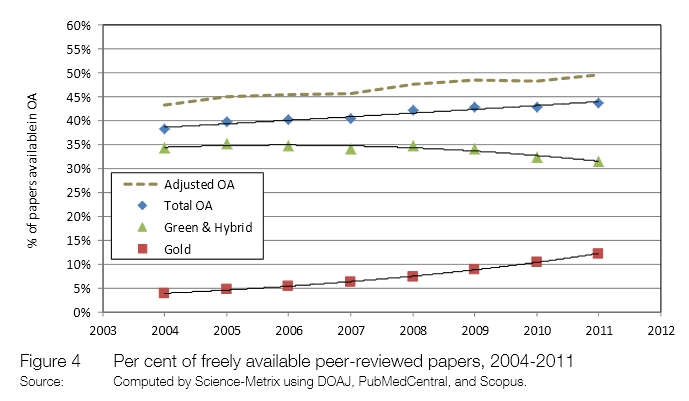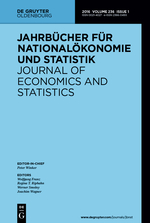European Commission: Open access to research publications reaching ‘tipping point’…but what about the data?
Posted: August 28th, 2013 | Author: Sven | Filed under: found on the net, Report | Tags: European Commission, open access, Open Data | Comments Off on European Commission: Open access to research publications reaching ‘tipping point’…but what about the data? The European Commission (EC) has released a press statement in which the EC claimed that “the global shift towards making research findings available free of charge for readers—so-called ‘open access’ is reaching ‘tipping point’.”
The European Commission (EC) has released a press statement in which the EC claimed that “the global shift towards making research findings available free of charge for readers—so-called ‘open access’ is reaching ‘tipping point’.”
This enthusiastic view of the Commission is based on three studies that that have been funded by the EC:
One study analysed the growth of open access publications, a second evaluated the strategies of funders to enforce open access and the a third addressed open access to scientific data.
The first study “Proportion of Open Access Peer-Reviewed Papers at the European and World Levels—2004-2011” found out that around 50% of all scientific papers published in 2011 are available freely within a year or two of publication. The study measured the availability of scholarly publications in 22 fields of knowledge across the European Research Area, Brazil, Canada, Japan, and the United States, between 2004 and 2011. It also estimates that more than 40% of scientific peer reviewed articles published worldwide between 2004 and 2011 are now available online in open access form.
The study also described that there are big differences among countries and disciplines: In some fields of research the proportion is even superior to 50%. For instance, this is the case for a majority of articles in the fields of general science and technology, biomedical research, biology and mathematics and statistics. Open access is more limited in the social sciences, humanities, and applied sciences, engineering and technology, science-metrix, a research evaluation firm who produced the three studies, stated.

Archambault et al. (2013). Proportion of Open Access Peer-Reviewed Papers at the European and World Levels—2004-2011, p. 13
There are also differences between the countries evaluated. For example the report states: ” Leaving aside smaller countries with only few papers in the sample (less than 100 papers), the countries with the lowest rate of OA adoption are Bulgaria, Poland, Greece, the Czech Republic, and Germany.” So still some more work to do for our OA-experts…
The second report “Open Access Strategies in the European Research Area” , focused on open access policies, showed a growing trend in the adoption of such policies by governments and other funding bodies. In a sample of 48 research funders, the report found that the majority considered both key forms of open access to be acceptable: open access publications in journals (referred to as “gold” and “hybrid” open access) and self-archiving (referred to as “green” open access). Delayed open access is widely accepted, as 75% of funding bodies allow embargo periods of 6 to 12 months.
A third report “Open Data Access Policies and Strategies in the European Research Area and Beyond” found out that open access to scientific data is less developed and more difficult to implement than open access to scholarly publications, both in terms of policies and infrastructure. This statement is not a surprise when we take into account that incentives to disclose research data, legal barriers and partially missing infrastructure for storing and sharing research data are evident.
Especially the incentive-challenge is also recognized by the study’s authors:” Whereas researchers have a ‘natural incentive’ to promote OA in the case of scholarly publications, as this makes their work more widely known, in some cases there might be negative incentives to make research data public. Researchers may indeed derive a competitive advantage by filling up their own data warehouse and widely diffusing these data may limit the growth and curtail the size of their research enterprise.”
The report also describes that funding bodies have far fewer OA policies for scientific data than they have policies for scientific publications. In an analysis conducted by Science-Metrix of 48 funders’ OA policies listed in ROARMAP within ERA countries, Brazil, Canada, and the US, 23% explicitly excluded data from OA requirements and 38% did not mention data at all. Conversely, 29% of policies mandated open data archiving and 10% encouraged it without mandating it.
OA policies for scientific data are less common than OA policies for scholarly publications. In a survey of head librarians at universities and higher learning institutions conducted by Science-Metrix, 73% of respondents agreed that providing scholarly publications in open access form is a priority in their organisation, whereas only 45% agreed that providing scientific data in open access form is a priority in their organisation.
A similar trend is observed in the adoption of OA policies for scholarly publications and scientific data. Only 11% of respondents indicated that their institution has an OA policy for scientific data, while for scholarly publications, 42% indicated that their institution has an OA policy. Thus, establishing institutional frameworks for the diffusion of data in open access remains a secondary concern at this point.
These three studies are available online:
- http://www.science-metrix.com/pdf/SM_EC_OA_Availability_2004-2011.pdf
- http://www.science-metrix.com/pdf/SM_EC_OA_Policies.pdf
- http://www.science-metrix.com/pdf/SM_EC_OA_Data.pdf
Graphics: 1 and 3 by pali_nalu /flickr.com. License:CC-BY-NC-2.0







